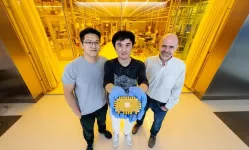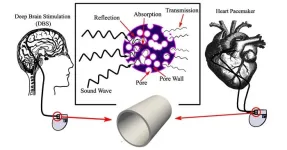(Press-News.org) Self-driving cars rely on artificial intelligence to predict where nearby cars will go. But when those predictions don’t match reality, that discrepancy can potentially lead to crashes and less safe roadways.
That’s why a recent study from the University of Georgia developed a new AI model to make self-driving cars safer.
This study introduces an AI model for self-driving cars, designed to predict the movement of nearby traffic and incorporate innovative features for planning safe vehicle movements.
"The planned trajectory of the self-driving car may turn out to collide with the actual trajectory of another vehicle.” —Qianwen Li, College of Engineering
The study used data from the I-75 freeway in Florida to predict other cars’ paths and determine the motion of the self-driving car when following another vehicle.
Previous research mostly predicts surrounding traffic movements and then plans a self-driving car’s motion. This separate approach, however, makes crashes and near-misses more likely.
“That’s why we wanted to consolidate those two steps — to make the autonomous vehicle operation safer,” said Qianwen Li, lead author of the study and an assistant professor in UGA’s College of Engineering. “And as illustrated by our experiments, that approach does help with safety performance.”
AI needs to do more than predict traffic
To keep drivers safe, self-driving cars have to be able to accurately anticipate the movements of surrounding traffic. However, it’s difficult to know what other drivers will do on the road.
“There are always differences between your prediction and the reality,” said Li. “The planned trajectory of the self-driving car may turn out to collide with the actual trajectory of another vehicle.”
The new model was designed to take prediction errors into account, as eliminating them isn’t possible.
Li’s group is also working on developing more complex AI models for self-driving car operations, such as large learning models like ChatGPT. Traffic scenarios could be fed to these models, and they would determine the best course of action.
However, large language models have limits. While they’re effective at making high-level decisions related to how to respond to different situations, planning the movements of a car isn’t what they’re built for.
“How do we make a perfect lane change that is safe and also efficient?” said Li. “How do we come to a smooth stop for pedestrians without inducing any riding discomfort? Basically, how do we design the specific trajectories? That part we do not ask ChatGPT or large language models to do because they do not have the capability to do so. Traditional trajectory optimization models can do a much better job based on our experiments so far.”
Balancing safety and mobility in vehicle artificial intelligence
Designing AI for self-driving cars is a balancing act. Maximizing safety often comes at the cost of mobility.
If a self-driving car is taught to drive as safely as possible, for example, it will stay far behind the car in front of it. While a safer option, that distance would likely reduce the number of cars that could fit on the roadway at a given time.
Similarly, focusing too much on mobility could result in cars driving too aggressively, increasing the risk of crashes.
“We’re still working on how we train the model in a way that can balance the safety and mobility performance,” said Li.
The study was published in Transportation Research Part E. Co-authors include Handong Yao of UGA’s College of Engineering, Xiaopeng Li of University of Wisconsin-Madison’s Department of Civil and Environmental Engineering, and Chenyang Yu of McGill University’s Mathematics and Computer Science Department.
END
Making self-driving cars safer, less accident prone
New AI model could enhance self-driving car safety
2024-12-10
ELSE PRESS RELEASES FROM THIS DATE:
Rethinking the quantum chip
2024-12-10
Researchers at the UChicago Pritzker School of Molecular Engineering (UChicago PME) have realized a new design for a superconducting quantum processor, aiming at a potential architecture for the large-scale, durable devices the quantum revolution demands.
Unlike the typical quantum chip design that lays the information-processing qubits onto a 2-D grid, the team from the Cleland Lab has designed a modular quantum processor comprising a reconfigurable router as a central hub. This enables any two qubits to connect and entangle, where in the ...
When does waiting stop being worth it?
2024-12-10
You’re standing at a bus stop, waiting for a ride that seems like it will never come. At first, you’re hopeful that it will be here any second. But as the minutes laggardly drag on, doubt creeps in. Should you keep waiting, or is it smarter to start walking or call for a ride?
“It’s a classic dilemma. “Do you persist with the belief that the bus is on its way, or do you cut your losses and move on to something else?” asks Joe Kable, a psychologist in the School of Arts ...
Nationwide study looks at when and where EV owners use public charging stations
2024-12-10
AUSTIN, TX, Dec 10, 2024 – Electric Vehicles (EVs) represent a promising mode of transportation that can help the United States reduce its carbon emissions. But barriers such as the high cost of installing and using EV Charging Stations (EVCS), their limitations in supplying emerging demand, and their uneven distribution throughout the country limit access for many Americans.
Researchers at the University of Maryland are using supercomputers and machine learning methods to analyze a full year of real-time data collected from individual EV charging ports at more than 50,000 publicly available stations throughout the country. The primary focus of the study is ...
A new discovery about the source of the vast energy in cosmic rays
2024-12-10
Ultra-high energy cosmic rays, which emerge in extreme astrophysical environments—like the roiling environments near black holes and neutron stars—have far more energy than the energetic particles that emerge from our sun. In fact, the particles that make up these streams of energy have around 10 million times the energy of particles accelerated in the most extreme particle environment on earth, the human-made Large Hadron Collider.
Where does all that energy come from? For many years, scientists believed it came from ...
Cancer ‘fingerprint’ can improve early detection
2024-12-10
Different types of cancer have unique molecular ‘fingerprints’ which are detectable in early stages of the disease and can be picked up with near-perfect accuracy by small, portable scanners in just a few hours, according to a study published today in the journal Molecular Cell.
The discovery by researchers at the Centre for Genomic Regulation (CRG) in Barcelona sets the foundation for creating new, non-invasive diagnostic tests that detect different types of cancer faster and earlier than currently possible.
The study centres around the ribosome, the protein factories of a cell. For decades, ribosomes were thought ...
Rethinking the brain pacemaker: How better materials can improve signals
2024-12-10
WASHINGTON, Dec. 10, 2024 – Two years ago, a medical professional approached scientists at the University of Tabriz in Iran with an interesting problem: Patients were having headaches after pacemaker implants. Working together to investigate, they began to wonder if the underlying issue is the materials used in the pacemakers.
“Managing external noise that affects patients is crucial,” author Baraa Chasib Mezher said. “For example, a person with a brain pacemaker may experience interference from external electrical fields from phones ...
Allostatic load, educational attainment, and risk of cancer mortality among us men
2024-12-10
About The Study: This study highlights the detrimental association of not attaining a high school degree, combined with high allostatic load as a marker of chronic stress, with cancer mortality. Efforts to promote educational attainment and address the underlying social determinants of health are imperative in reducing cancer disparities in this population.
Corresponding Author: To contact the corresponding author, Justin X. Moore, PhD, MPH, email jx.moore@uky.edu.
To access the embargoed study: Visit our For The Media website at this link ...
Flaw in computer memory leads to global security fixes
2024-12-10
Cyber security experts studying memory modules in computers have uncovered a key security weakness that has led to worldwide security fixes in AMD computer processors.
The weakness occurs because of ‘BadRAM’ - rogue memory modules that deliberately provide false information to the computer’s processor during startup.
Processors are present in every computer and are necessary to perform every calculation. The computer’s memory (DRAM) is essential for storing code and data. When a computer ...
Race, ethnicity, and sleep in us children
2024-12-10
About The Study: In this cross-sectional study of children’s sleep disparities, racially and ethnically minoritized children exhibited disparities in mean levels and variability of sleep compared with their white peers. These findings suggest that policies and practices should target multiple sleep dimensions among diverse racial and ethnic groups to promote equitable pediatric sleep health.
Corresponding Author: To contact the corresponding author, Yijie Wang, PhD, email yjwang@msu.edu.
To access the embargoed study: Visit our For The Media website at this link https://media.jamanetwork.com/
(doi:10.1001/jamanetworkopen.2024.49861)
Editor’s ...
Geriatric surgery verification program can improve outcomes for older cancer patients in community hospitals
2024-12-10
Key takeaways
The American College of Surgeons Geriatric Surgery Verification program significantly decreases hospital stays among older cancer patients, according to researchers who implemented the program at their institution.
After implementing the program, patients undergoing major abdominal oncologic procedures also maintained higher levels of independence and were more likely to be discharged home.
Researchers found the program addresses the unique needs of older cancer patients by focusing on multiple aspects of care.
CHICAGO — ...
LAST 30 PRESS RELEASES:
Numbers in our sights affect how we perceive space
SIMJ announces global collaborative book project in commemoration of its 75th anniversary
Air pollution exposure and birth weight
Obstructive sleep apnea risk and mental health conditions among older adults
How talking slows eye movements behind the wheel
The Ceramic Society of Japan’s Oxoate Ceramics Research Association launches new international book project
Heart-brain connection: international study reveals the role of the vagus nerve in keeping the heart young
Researchers identify Rb1 as a predictive biomarker for a new therapeutic strategy in some breast cancers
Survey reveals ethical gaps slowing AI adoption in pediatric surgery
Stimulant ADHD medications work differently than thought
AI overestimates how smart people are, according to HSE economists
HSE researchers create genome-wide map of quadruplexes
Scientists boost cell "powerhouses" to burn more calories
Automatic label checking: The missing step in making reliable medical AI
Low daily alcohol intake linked to 50% heightened mouth cancer risk in India
American Meteorological Society announces Rick Spinrad as 2026 President-Elect
Biomass-based carbon capture spotlighted in newly released global climate webinar recording
Illuminating invisible nano pollutants: advanced bioimaging tracks the full journey of emerging nanoscale contaminants in living systems
How does age affect recovery from spinal cord injury?
Novel AI tool offers prognosis for patients with head and neck cancer
Fathers’ microplastic exposure tied to their children’s metabolic problems
Research validates laboratory model for studying high-grade serous ovarian cancer
SIR 2026 delivers transformative breakthroughs in minimally invasive medicine to improve patient care
Stem Cell Reports most downloaded papers of 2025 highlight the breadth and impact of stem cell research
Oxford-led study estimates NHS spends around 3% of its primary and secondary care budget on the health impacts of heat and cold in England
A researcher’s long quest leads to a smart composite breakthrough
Urban wild bees act as “microbial sensors” of city health.
New study finds where you live affects recovery after a hip fracture
Forecasting the impact of fully automated vehicle adoption on US road traffic injuries
Alcohol-related hospitalizations from 2016 to 2022
[Press-News.org] Making self-driving cars safer, less accident proneNew AI model could enhance self-driving car safety


